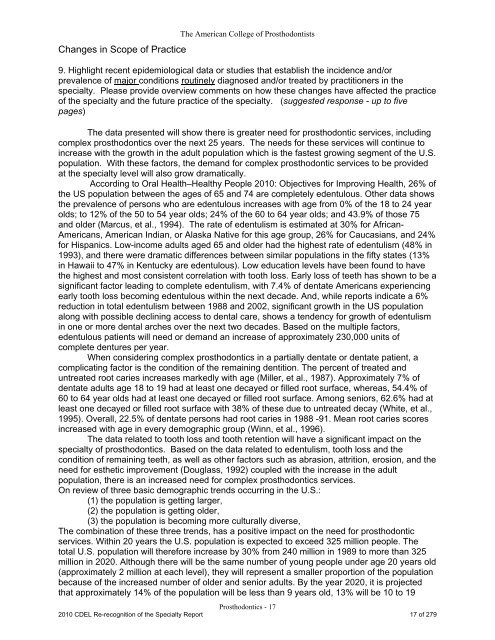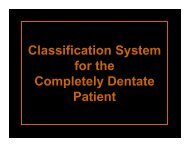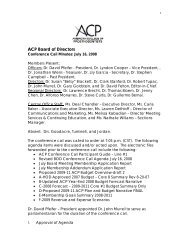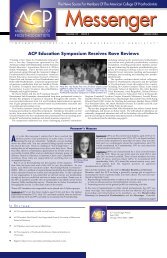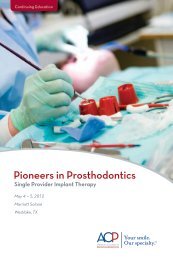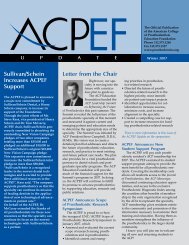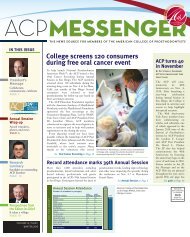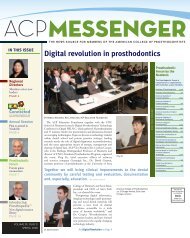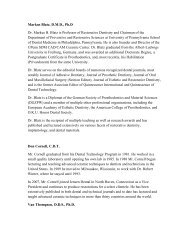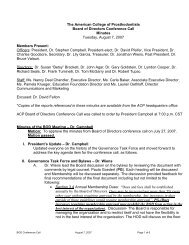PROSTHODONTICS - American College of Prosthodontists
PROSTHODONTICS - American College of Prosthodontists
PROSTHODONTICS - American College of Prosthodontists
Create successful ePaper yourself
Turn your PDF publications into a flip-book with our unique Google optimized e-Paper software.
Changes in Scope <strong>of</strong> PracticeThe <strong>American</strong> <strong>College</strong> <strong>of</strong> <strong>Prosthodontists</strong>9. Highlight recent epidemiological data or studies that establish the incidence and/orprevalence <strong>of</strong> major conditions routinely diagnosed and/or treated by practitioners in thespecialty. Please provide overview comments on how these changes have affected the practice<strong>of</strong> the specialty and the future practice <strong>of</strong> the specialty. (suggested response - up to fivepages)The data presented will show there is greater need for prosthodontic services, includingcomplex prosthodontics over the next 25 years. The needs for these services will continue toincrease with the growth in the adult population which is the fastest growing segment <strong>of</strong> the U.S.population. With these factors, the demand for complex prosthodontic services to be providedat the specialty level will also grow dramatically.According to Oral Health–Healthy People 2010: Objectives for Improving Health, 26% <strong>of</strong>the US population between the ages <strong>of</strong> 65 and 74 are completely edentulous. Other data showsthe prevalence <strong>of</strong> persons who are edentulous increases with age from 0% <strong>of</strong> the 18 to 24 yearolds; to 12% <strong>of</strong> the 50 to 54 year olds; 24% <strong>of</strong> the 60 to 64 year olds; and 43.9% <strong>of</strong> those 75and older (Marcus, et al., 1994). The rate <strong>of</strong> edentulism is estimated at 30% for African-<strong>American</strong>s, <strong>American</strong> Indian, or Alaska Native for this age group, 26% for Caucasians, and 24%for Hispanics. Low-income adults aged 65 and older had the highest rate <strong>of</strong> edentulism (48% in1993), and there were dramatic differences between similar populations in the fifty states (13%in Hawaii to 47% in Kentucky are edentulous). Low education levels have been found to havethe highest and most consistent correlation with tooth loss. Early loss <strong>of</strong> teeth has shown to be asignificant factor leading to complete edentulism, with 7.4% <strong>of</strong> dentate <strong>American</strong>s experiencingearly tooth loss becoming edentulous within the next decade. And, while reports indicate a 6%reduction in total edentulism between 1988 and 2002, significant growth in the US populationalong with possible declining access to dental care, shows a tendency for growth <strong>of</strong> edentulismin one or more dental arches over the next two decades. Based on the multiple factors,edentulous patients will need or demand an increase <strong>of</strong> approximately 230,000 units <strong>of</strong>complete dentures per year.When considering complex prosthodontics in a partially dentate or dentate patient, acomplicating factor is the condition <strong>of</strong> the remaining dentition. The percent <strong>of</strong> treated anduntreated root caries increases markedly with age (Miller, et al., 1987). Approximately 7% <strong>of</strong>dentate adults age 18 to 19 had at least one decayed or filled root surface, whereas, 54.4% <strong>of</strong>60 to 64 year olds had at least one decayed or filled root surface. Among seniors, 62.6% had atleast one decayed or filled root surface with 38% <strong>of</strong> these due to untreated decay (White, et al.,1995). Overall, 22.5% <strong>of</strong> dentate persons had root caries in 1988 -91. Mean root caries scoresincreased with age in every demographic group (Winn, et al., 1996).The data related to tooth loss and tooth retention will have a significant impact on thespecialty <strong>of</strong> prosthodontics. Based on the data related to edentulism, tooth loss and thecondition <strong>of</strong> remaining teeth, as well as other factors such as abrasion, attrition, erosion, and theneed for esthetic improvement (Douglass, 1992) coupled with the increase in the adultpopulation, there is an increased need for complex prosthodontics services.On review <strong>of</strong> three basic demographic trends occurring in the U.S.:(1) the population is getting larger,(2) the population is getting older,(3) the population is becoming more culturally diverse,The combination <strong>of</strong> these three trends, has a positive impact on the need for prosthodonticservices. Within 20 years the U.S. population is expected to exceed 325 million people. Thetotal U.S. population will therefore increase by 30% from 240 million in 1989 to more than 325million in 2020. Although there will be the same number <strong>of</strong> young people under age 20 years old(approximately 2 million at each level), they will represent a smaller proportion <strong>of</strong> the populationbecause <strong>of</strong> the increased number <strong>of</strong> older and senior adults. By the year 2020, it is projectedthat approximately 14% <strong>of</strong> the population will be less than 9 years old, 13% will be 10 to 19Prosthodontics - 172010 CDEL Re-recognition <strong>of</strong> the Specialty Report 17 <strong>of</strong> 279


